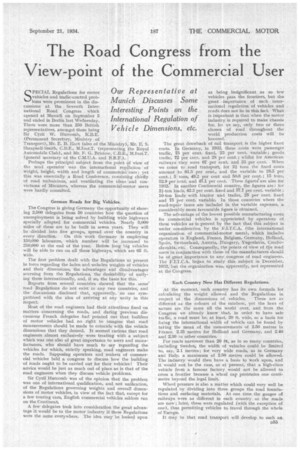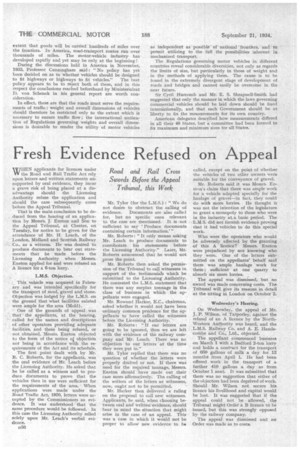The Road Congress from the View-point of the Commercial User
Page 113

Page 114

If you've noticed an error in this article please click here to report it so we can fix it.
SPECIAL Regulations for motor vehicles and traffic-control prob. 'emswere prominent in the discussions at the . Seventh International Road Congress which opened at Munich on .September 3 and ended in Berlin last Wednesday. There were more than 250 British representatives, amongst them being Sir Cyril W. Hurcomb, K.B.E. .(Permanent Secretary, Ministry . of Transport), Mr. E. B. Hart (also of the Ministry), Mr. E. S. Shrapnell-Smith, C.B.E., M.Inst.T. (representing the Royal Automobile Club), and Mr. F. G. Bristow, C.B.E., M.Inst.T. (general secretary of the C.M.I.J.A. and BR-F.).
Perhaps the principal subject from the point of view of the wad operator was the international regulation of weight, height, width and length of commercial cars ; yet this was essentially a Road Conference, consisting chiefly of road technicians, and ventilating the ideas and convictions of Ministers, whereas the commercial-motor users were hardly consulted. .
German Roads for Big Vehicles.
The Congress is giving Germany the opportunity of showing 2,500 delegates from 50 countries how the question of unemployment is being solved by building wide highways specially adapted for commercial vehicles. Nearly 5,000 miles of these are to be built in seven years. They will be, divided . into five groups, spread over the country in every direction. On this work Germany is employing 150,000 labourers, which number will be increased to 250,000 at the end of the year. Before long big vehicles will be able to run on all thee highways, which are 65 ft.
wide. • The first problem dealt with the Regulations at present in force regarding the laden and unladen weights of vehicles and their dimensions, the advantages and disadvantages accruing from the Regulations, the desirability of unifying them internationally, and, if so, the basis for this.
Reports from several countries showed that the same' road Regulations do not exist in any two countries, and the discussions disclosed that, apparently, no one sympathized with the idea of arriving at any unity in this respect.
Most of the road engineers had their attentions fixed on matters concerning the roads, and during previous discussions French delegates had pointed out that builders of motor vehicles had no right to imagine that road measurements should be made to coincide with the vehicle dimensions that they desired. It seemed curious that road engineers almost exclusively were treating with a subject which was one also of great importance to users and manufacturers, who should have much to say regarding the vehicles for which, strictly speaking, road engineers make the roads. Supposing operators and makers of commercial vehicles held a congress to discuss bow the building of roads ought to he carried out for their vehicles! Their advice would be just as much out of place as is that of the road engineers when they discuss vehicle problems.
Sir Cyril Hurconab was of the opinion that the problem was one of international qualification, and not unification, of the Regulations governing weights and overall dimensions of motor vehicles, in view of the fact that, except for a few touring cars, English commercial vehicles seldom run on the Continent.
A few delegates took into consideration the great advantage it would be to the motor industry if these Regulations were the same everywhere. The idea may be looked upon
as being insignificant as so few vehicles pass the frontiers, but the great importance of such international regulation of vehicles and reads does not lie in this fact. What is important is that when the motor industry is required to make chassis for, let us say, only two or three classes of road throughout the world production costs will be lowered.
The great drawback of rail transport is the higher fixed costs. In Germany, in 1932, these costs were passenger traffic, 75 per cent. fixed, 25 per cent, -t-ariable ; goods traffic, 72 per cent. and 23 per cent. ; whilst for American railways they were 67 per cent. and 33 per cent. . When we come to road transport, for 2i tons the fixed costs amount to 61.5 per cent., and the variable to 38.5 per cent. ; 5 tons, 49.2 per cent and 50.8 per cent ; 15 tons, 52.9 per cent. and 47.1 per cent. These figures' are also for 1982. In another Continental country, the figures are: for 2i-ton loads, 42.3 per cent, fixed and 57.7 per cent. variable ; 10-ton loads with tractor and trailer, 25 per cent, fixed and 75 per cent. variable. In those countries where the road-repair taxes are included in the variable expenses, a considerably more favourable figure is obtained.
The advantage of the lowest possible manufacturing costs for commercial vehicles, is appreciated by .operators of these vehieles as is proved by the fact that this subject is under consideration by the F.I.T.C.A. (the international organization of commercial-motor users), which includes operators in England, France, Belgium, Germany, Holland, Spaiti, Switzerland, Austria, Hungary, Yugoslavia, Cradleslovalcia, etc. Consequently,. the points of view of the road users in conjunction with those of the manufacturers should be of great importance to any . congress of road engineers. The F.I.T.C.A. began to study this subject in December, 1933, but the organization was, apparently, not represented at the Congress: Each Country Now Has Different Regulations.
At the moment, each country has its own formula for calculating the weight allowed and the Regulati.ons in
respect of the dimensions of vehicles. These are as different as the colours of the rainbow, yet the laws of nature are the same all the world over, and from the Congress we already know that, in ordet to have safe traffic, a road must be, at least, 20 ft. wide, so a basis for fixing the international width of vehicle can be found by taking the Mean of the measurements of 2.50 metres in France, 2.35 metres for Holland and Germany, and 2A0 and 2.30 in other countries.
For roads narrower than 20 ft, as in so many countries, including Sweden, the width of vehicles could be limited to, say, 2.1 metres ; for very wide roads, as in Germany and Italy; a maximum of 2.50 metres could be allowed. The industry would then have a basis to work upon, and it would not be the case, as at present, that a high-class vehicle from a famous factory would not be allowed to cross a frontier because a wheel cap protrudes one centimetre beyond the legal limit.
Wheel pressure is also a matter which could very well be regulated by dividing into three groups the road foundations and surfacing materials. At one time the gauges of railways were as different in each country as the roads are now ; later, these were regulated (with the exception of one), thus permitting vehicles to travel through the whole of Europe.
It may be that road transport will develop to such aD D55
extent that goods will be carried hundreds of miles over the frontiers. In America, road-transport routes run over thousands of miles. The motor-vehicle industry has. developed rapidly and yet may be only at the beginning! During the discussions held in America in November, 1933, Professor Cunningham said : " No policy has yet been decided on as to whether vehicles should be designed to fit highways or highways to fit vehicles." The best policy appears to be to reject both of these, and in this respect the conclusions reached beforehand by Ministerialrat D. von Schenck in his general report are worth con sideration. '
In effect, these are that the roads must serve the requirements of traffic ; weight and overall dimensions of vehicles should therefore be restricted only to the extent which is necessary to ensure traffic flow; the international unification of Regulations governing weights and overall dimensions is desirable to render the utility of motor vehicles as independent as possible of national' frontiers, and to permit utilizing to the full the possibilities inherent in mechanized transport.
The Regulations governing motor vehicles in different countries reveal considerable diversities, not only as regards the limits of size, but particularly in those of weight and in the methods of applying them. The cause is to be found in the extremely divergent stage of development of roads and bridges and cannot easily be overcome in the near future.
Sir Cyril Hurcomb and Mr. E. S. Shrapnell-Smith had suggested that only the manner in which the laws governing commercial vehicles should be laid down should be fixed internationally, and that each Government should be at liberty to fix the measurements for its own country.
American delegates described how measurements differed in all their 48 States, but a committee had been formed to fix maximum and minimum sizes for all States.








































































































































































